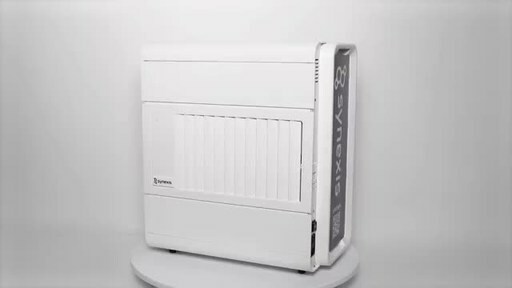LENEXA, Kan., July 15, 2021 /PRNewswire/ -- Synexis® LLC, a pioneer in microbial reduction and sole developer of patented technology that creates Dry Hydrogen Peroxide (DHP™) for occupied spaces, today announced that DHP™ begins reducing viral load in larger indoor spaces (total volume 5,940 ft3) in 45 minutes, and significantly reduces surface levels of infectious SARS-CoV-2 virus in 120 minutes of continuous treatment.1 These results were included in an independent study published today in the American Journal of Infection Control.
"Under rigorous laboratory test conditions, the portable Synexis Dry Hydrogen Peroxide device significantly reduced the levels of infectious SARS-CoV-2 virus, the virus which causes COVID-19, on hard surfaces, in just two hours," said Stephen Higgs, Ph.D., F.R.E.S., F.A.S.T.M.H., associate vice president for research, director, Biosecurity Research Institute (BRI), the lead investigator on the study.
To determine if DHP technology was active against SARS-CoV-2 viral contamination in larger spaces, scientists at the BRI exposed virus-contaminated surfaces (glass slides) to DHP technology for up to 24 hours and used an ambient-air, untreated room as the control environment. The study was conducted in 50m2 rooms (approximate total volume 5,940 ft3), simulating a more real-world environment with standard air exchanges. Samples were then analyzed to learn whether DHP technology could enhance the decay of infectious SARS-CoV-2 particles. Viral samples in the room treated with DHP began to show numerical reductions versus the ambient-air control group at 45 and 60 minutes and reached statistical significance at 120 minutes. After 120 minutes of DHP treatment, SARS-CoV-2 concentrations were significantly reduced by 98.7% (1.8log10TCID50/ml in the DHP-treated room versus 3.1log10TCID50/ml in the untreated room, p = 0.01).1 Additionally, one-third (33.3%) of DHP-treated samples did not contain detectable viruses at both 240 and 1,440 minutes after the initiation of treatment.
"Cleaner surfaces reduce the risk of indirect contact transmission of SARS-CoV-2, which is essential for the safe reopening of businesses and schools," said Eric Schlote, CEO of Synexis. "This peer-reviewed study shows that DHP significantly reduces SARS-CoV-2 on surfaces. It adds to a growing body of evidence showing DHP is effective at reducing bacteria, mold and viruses, including SARS-CoV-2 that causes COVID-19."
Synexis technology deploys DHP to actively clean the air and surfaces.2 DHP molecules travel throughout an enclosed space to reduce viruses, bacteria, mold, odors and many insects.3 Generated from ambient humidity and oxygen naturally present in the environment, DHP can be effectively delivered in occupied spaces at levels well below occupational airborne safety standards established by OSHA, which allows for continuous microbial reduction without disturbing normal operations and workflow.4 DHP is able to impact contaminants in the air and on surfaces in hard-to-reach places.
ABOUT SYNEXIS
Founded in 2008, Synexis® LLC is a leader in microbial reduction and the sole developer of patented technology that creates and continuously disperses DHP™ to help reduce the presence of microbes in indoor spaces around the clock, without the need for occupants to leave the space.
Synexis develops cutting-edge biodefense systems designed to make the air and surfaces cleaner. Synexis BioDefense systems are regulated by the U.S. Environmental Protection Agency (EPA) and state governments as antimicrobial devices. Accordingly, Synexis Systems are produced in an EPA-registered facility and packaged and labeled in accordance with EPA regulations appearing at 40 CFR 152.500. The Synexis system is Underwriter Laboratories (UL) Certified to produce no ozone and works continuously without disruptions in normal operations or workflow.5 Synexis currently has 16 approved U.S. patents with 17 pending.2 In addition, Synexis DHP™ technology is supported by data from six peer-reviewed studies.1,3,6,7,8,9
For more information, visit Synexis.com.
1 Yan-Jang S. Huang PhD , Ashley N. Bilyeu , Wei-Wen Hsu PhD , Susan M. Hettenbach , Joshua L. Willix PhD , Savannah C. Stewart MS , Stephen Higgs PhD , Dana L. Vanlandingham PhD, MS , Treatment with Dry Hydrogen Peroxide Accelerates the Decay of Severe Acute Syndrome Coronavirus-2 on Non-porous Hard Surfaces, AJIC: American Journal of Infection Control (2021), doi: https://doi.org/10.1016/j.ajic.2021.07.006 |
||
2 Synexis https://synexis.com/patents/. Accessed April 23, 2021. |
||
3 Herman CK, Hess J, Cerra C. Dilute Hydrogen Peroxide Technology for Reduction of Microbial Colonization in the Hospital Setting. AJIC. 2015;43(6S):S25-S26. doi: 10.1016/j.ajic.2015.04.064. |
||
4 Occupational Safety and Health Administration. https://www.osha.gov/dsg/annotated-pels/tablez-html.Accessed August 14, 2020. |
||
5 UL Certification numbers: Blade UL E482400 and Sentry UL E495096. |
||
6 Infection Specialists and Pharmacists Share Responsibility for Ensuring Patient Safety; Pharmacy Times. Published November 23, 2020. |
||
7 Melgar, M., et al. Effectivness of dry hydrogen peroxide on reducing environmental microbial bioburden risk in a pediatric oncology intensive care unit. AJIC (2020). https://doi.org/10.1016/j.ajic.2020.08.026. |
||
8 Melo, E.F. & McElreath, J.S. & Wilson, J.L. & Lara, Leonardo & Cox, N.A. & Jordan, Brian. (2020). Effects of a dry hydrogen peroxide disinfection system used in an egg cooler on hatchability and chick quality. Poultry Science. Vol. 99, Nov. 2020. https://doi.org/10.1016/j.psj.2020.05.050. |
||
9 Sanguinet, J., & Edmiston, C. Evaluation of dry hydrogen peroxide in reducing microbial bioburden in a healthcare facility. AJIC (2021). |
||
SOURCE Synexis LLC

Related Links
WANT YOUR COMPANY'S NEWS FEATURED ON PRNEWSWIRE.COM?
Newsrooms &
Influencers
Digital Media
Outlets
Journalists
Opted In





Share this article